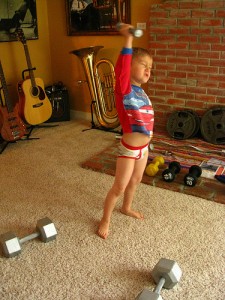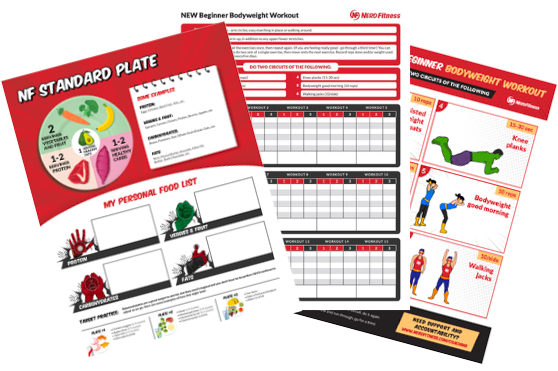Every day in gyms across the country, there are poor, misguided fools who kind of suck at working out.
They either don’t know what they’re doing, or they THINK they know what they’re doing when they really don’t. You might fit into one of these groups, and that’s okay. You’re here and reading, which is step one.
If you work out in a gym, today’s post will make sure you’re not one of those people.
Although I’m not the biggest guy in the world, I practice safe routines when lifting, I go for balance and functional movement over superficial but weak practices, I have a level head, strong convictions, and I do my best to stay up to date on the latest books, studies, journals, and information when it comes to getting strong and staying in shape.
Essentially, I’ve suck-proofed my workout routines (yeah, I said “suck-proofed”). I’m going to tell you exactly why most people suck at working out, and what you can do to suck-proof yourself:
Have a Game Plan
 How are you going to be better today than you were yesterday?
How are you going to be better today than you were yesterday?
If you don’t know exactly what you expect to accomplish, how will you know when you get there? It’s like driving a car: you start at point A, and you need to get to point B. If you don’t make it to point B, you either got lost, or your car broke down. Every day, I see WAY too many people wandering aimlessly in the gym, doing one set at a machine, wandering to the next, barely breaking a sweat, and then walking out of there having accomplished absolutely NOTHING. Those people suck and are wasting their time.
Here’s how you can NOT suck:
- Define your Point B: If you did 8 pull ups last week, this week you need to try and do 9. If you bench pressed 100 pounds, this week you need to do at least 101 pounds to be stronger.
- Make sure point B is possible: If you ran a mile in 9 minutes yesterday, setting your goal today at 6 minutes is ludicrous. Set that goal at something better than previous goals, but one that’s actually reachable.
- Make sure your “car” won’t break down: This goes along with the previous point. Make sure you’ve had enough sleep, you’re eating well, you’re in a good frame of mind, and you’re not sick before stepping in that gym.
- Keep your eyes on the road: Don’t wander around like a jackass. Don’t stop and talk to everybody you see. Don’t spend 5 minutes at the water fountain because it’s next to the yoga room full of women. Map out your route before you get in there, put in your headphones, keep your head down, take care of business, and get the hell out of there!
- Plan a quick route: You don’t need to spend 2 hours in a gym six days a week to see results. Just three 45-minute weight-training sessions is enough to pack on some serious muscle if you give it everything you go each time you’re in there. If you’re trying to lose weight, go for higher intensity and less time, rather than 2-hours of steady-cardio (ugh).
Machines and Free Weights are Not Created Equal
 Don’t be afraid to use free weights.
Don’t be afraid to use free weights.
I watch WAY too many people doing squats on the Smith Machine and destroying their lower backs, using the pec-deck machine and jacking up their shoulders, and doing leg-extensions and screwing up their knees.
Everybody thinks machines are safer, when in reality they’re only safer if you’re concerned you’d drop a free weight on your head or something.
Other than this, machines are actually much worse for your body.
Our bodies are meant to move in a certain way. When you lift free weights, your body has a natural range of motion, using all your tiny stabilizer muscles to balance the weight as you lift it up and down. When you use a machine, your body doesn’t need to use those stabilizer muscles because the machine is doing all the stabilization. It’s these tiny muscles that keep you in balance and injury-free
If you’ve been training exclusively on machines, when you have to actually do these movements in real life (give your kids a piggy-back ride, move your roommate’s couch, or rake leaves in the back yard, that natural movement has become “unnatural” to your body and you’re way more likely to get injured.
Don’t be that guy. Here’s how:
- Do all of your exercises with free weights or just your body weight. Machines get you started down the wrong path, do exercises that recruit as many muscle groups as possible: squats, deadlifts, bench presses and shoulder presses, pull ups and chin ups.
- Practice Good Form. If you do your exercises with free weights with proper form, you will be strengthening your body in the right way, keeping you balanced and injury-free. Woooooo!
- When doing free weight exercises like the bench press, ask for a spotter – you do NOT want to drop the weight on your throat like that USC dude. Ask the guy nearest you for a spot, let him know how many you hope to get (8 reps, 5 reps, 6 reps and I’ll need help on the last one, etc.). Talk it out.
- If you don’t have free weights, use your body – Check out my other article “No gym? no problem” to see how you can get a great workout using just your body weight.
Be Careful Where You Get Your Fitness Advice
The other day, I looked over at the squat rack and watched as the gym’s CERTIFIED PERSONAL TRAINER set up an extremely overweight man (350 lbs+) to do heavy smith machine squats. The guy could barely hold himself up but was putting his knees and lower back under even more pressure.
Now, I’m a big fan of squats, and I think they’re one of the best exercises out there for both losing weight and building muscle. However, I shuddered just thinking about what this guy’s legs, back, organs, spine, and skeleton are doing on a daily basis just trying to carry around all that weight. When you’re this size, body weight squats are more than enough to get a workout going…adding lots of weight on an untrained body is just asking for a knee to get blown out.
I blame the trainer, who sucks at teaching others to not suck. Don’t fall into that trap:
- Be careful who gives you advice – Just because he’s a “certified personal trainer” doesn’t mean he knows what he’s talking about. A lot of trainers at these gyms don’t really know what they’re doing. It’s on you: do a little bit of research online and come up with a great routine that fits your specific situation.
- Be wary of advice from random people – I was training a client a few months back, having him do some body weight dips. Some random dude wandered over and told us that we should be going WAY down past parallel on each dip. I thanked the man for his advice, and then continued to train my guy to do the dips the same way he had been doing them to make sure he didn’t mess up his shoulders (which had been an issue for him in the past). Just because he’s dishing out advice doesn’t mean it’s right.
- If it hurts, don’t do it! Better safe than sorry. If you’re doing an exercise and it’s causing pain (not sore muscle pain, but actual pain), you’re either doing an unsafe exercise or you’re doing it incorrectly. Go home, look up the proper technique, and make sure you’re doing it right. We’re all nerds, be smart about it!
It’s Not What You Lift, It’s How You Lift It
Let’s get one thing straight: nobody cares how much you’re lifting at the gym.
You’re not there to impress people, you’re not there to show off, and you’re not there to get everybody’s attention – you’re there to get stronger and live better.
Every freaking day, I walk into the gym and see people doing exercises with attrocious form. 99% of the time, it’s because they’re trying to lift too much weight.
If you’re going to do bicep curls, your back does NOT need to be involved.
If you’re going to do a bench press, arching your back 6 inches off the bench and bouncing the weight back to the top doesn’t really count.
If you load up 3 plates on each side of the bar and then only squat down two inches, you’re wasting your time.
These people all suck at working out because they’re trying to do too much. If you don’t want people laughing at you behind your back and you don’t want to get seriously injured:
- Pick the right amount of weight – Unless you can complete each rep with perfect form, you’re cheating. Drop the weight, make sure your form is perfect, and then add weight in small increments when you’re ready.
- Complete a FULL REP – Watching people do “squats” at my gym drives me nuts. If you can’t squat down until your thighs are parallel (or lower) to the floor, you’re doing too much weight. I have so much more respect for somebody doing just bodyweight squats down to parallel than somebody loading up 6 plates on each side of a bar and then half-assing it. If you have to, start with just the bar on your shoulders and add weight from there.
- The more muscles you can involve in an exercise, the more efficient your workout will be. Which brings me to my next point…
Leave the Isolation Exercises to the Bodybuilders
This is true in every gym in the country: too many people are doing bicep curls, machine bench presses, calf-raises, shoulder shrugs, tricep kickbacks, and ab exercises.
Unless you are training for a bodybuilding competition or you’re already in incredible shape and need specific muscle growth, you don’t really need to concern yourself with any of these exercises.
Why? Because you’re going to work each and every muscle with COMPOUND EXERCISES and do it in a much safer and more balanced fashion. What should you do instead?
- Bicep curls – When you do pull ups, chin ups, and rows, your back, biceps, and forearms are getting a crazy workout. Mix in bicep curls as an end-of-workout move, not the foundation of your daily routine.
- Shrugs – It seems like everybody does shoulder shrugs (and 95% of those people are doing them wrong, which is super unsafe). Do deadlifts instead, which works every muscle in your legs, back, forearms, shoulders…and traps. Three sets of heavy deadlifts will have your traps poppin’.
- Calf raises – Squats, lunges and deadlifts! Sensing a theme yet? Learn to love these exercises, as they’ll give your legs all the workout they need. If you really want to work those calves extra, try running or jumping rope barefoot on off-days.
- Tricep kickbacks and shoulder raises – Don’t concern yourself with isolating each part of your triceps and shoulders with 18 different exercises. It’s a waste of time. Not only that, but tricep kickbacks can wreak havoc on your shoulders! Do dips, chest presses, push ups, and overhead presses. These all work your chest, shoulders, and triceps at the same time.
Need another reason? A body in balance is a body ready to stay strong and away from injury. If you do just bench presses, bicep curls, and leg-extensions, all of the muscles on the opposite side of your body (quads-hamstrings, chest-back, biceps-triceps) go out of balance, which is a recipe for disaster.
Here’s how you can fix that:
- Compound exercises are your friend: deadlifts, squats, pull ups, chin ups, bench presses, shoulder presses, and inverted rows – these exercises are your bread and butter. Instead of doing 1 muscle group a day (which isn’t real-world friendly), do 3 days of full-body workouts utilizing some of these exercises and you’ll be a more balanced (and thus more safe) individual.
- Don’t worry about crunches and ab workouts: When you do deadlifts and squats properly, your core (lower back and abs) are getting a super workout just trying to keep your body in balance. Also, you could do 8 million crunches, but unless your body fat is below 10%, you won’t see your abs. Floor crunches only give you half the range of motion and can do a number on your lower back. Keep your ab muscles contracted for every exercise and work on cutting your body fat (it’s all diet folks), and you’ll see those abs. If you do want to do some ab exercises at the end of your workout, try some planks, hanging knee tucks, or side planks!
Warm Up BEFORE and Stretch AFTER
- Before: Don’t walk into a gym and immediately start loading plates onto a bar. Get at least 5-10 minutes of warm-up exercises in there to get your heart rate going and your muscles warmed up. This will get you ready for lifting. If you just start lifting right away when you’re still “cold,” you could get injured, injured bad. Here’s a good warm up routine
- After: When you lift weights, your muscles get all contracted, tight, and jacked up. To kick-start your recovery process, stretch those muscles out after lifting weights to spread them back out and allow your muscle building system to operate more efficiently. According to power lifting guru Pavel Tsatsouline, “The benefits of stretching are enormous. Stretching can increase your strength by 10%. It is a lot.” Don’t forget to stretch! Here are some good stretching routines
Don’t be An Idiot and Other Random Thoughts
- If you just burned 300 Calories on the treadmill, chugging a 32 oz Gatorade will undo everything you just did. It’s like a giant control+Z for your body. Calories in must be less than calories burned for you to lose weight. All calories (even liquid ones) count. Don’t be stupid.
- Leave the pieces of flair at home. Weight belts, gloves, wrist straps, and other various “support mechanisms” can actually doing you more harm than good. Unless you’ve suffered a serious back injury in the past, or have been instructed to wear it by your powerlifting coach, you should be able to do your squats and deadlifts without a weight belt.
- Don’t sit on a bench and then talk for 10 minutes between sets. Other people are waiting to use the equipment, so get your sets done and move on.
- Walk out of that gym sweating. If you don’t walk out of that gym with a shirt drenched in sweat, you weren’t working hard enough. Give it everything you got in those 45 minutes, and make the most of your time when you’re in there.
I’m sure there are some other bits of suck-proof advice that I left out, so feel free to add your advice in the comments. If I can help just one misguided person from not sucking…I’ll consider today’s 2700-word post a success.
-Steve
###
Pictures from EricMcGreggor, EyeLiam.


